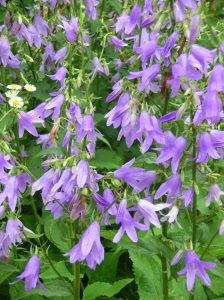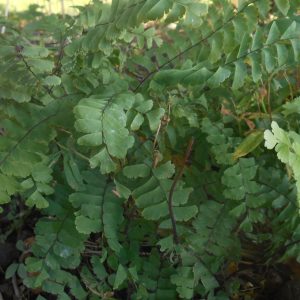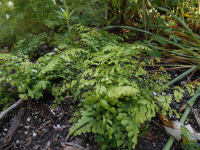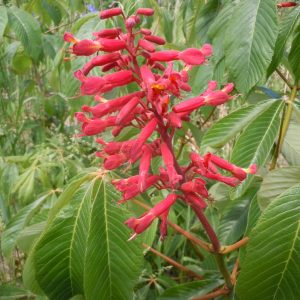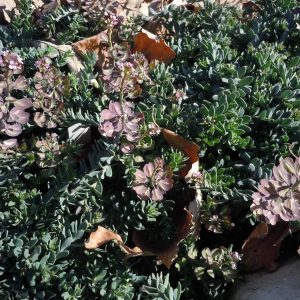Shop
Showing 17–24 of 788 results
-
Adenophora lilifolia Ladybells Z 3-8
Fragrant, flared, drooping bluebells in midsummer, July and August
Fragrant, flared, drooping bluebells in midsummer, July and August
Size: 18" x 12" spreading
Care: full sun to part shade in moist, well-drained soil
Native: central Europe east to SiberiaAdenophora is Greek from aden meaning “gland” and phore meaning “to bear.” Named and renamed many times from 1753. “Fragrant blue flowers, freely borne on a loose pyramidal inflorescence.” H.H. Thomas, 1915. “Well suited for the mixed border.” William Robinson, 1899.
-
Adiantum aleuticum Western Maidenhair Fern Z 3-9
Bright green fronds perch atop black stems like the fingers of an open hand
OUT OF STOCK
Bright green fronds perch atop black stems like the fingers of an open hand
Size: 30” x 30”
Care: shade in moist, well-drained soil
Native: East and west of the Cascade Mountains and is also found scattered along the eastern seaboard
Wildlife Value: Deer resistant
Awards: Elisabeth C Miller Great Plant Pick, Royal Horticultural Society Award of Garden MeritAccording to folklore if a girl can hold the stem without causing the leaves to tremble, then she was chaste.
Natives used the stems in basketry designs and made tea from the leaves to use as a hair wash. Quinault burnt the leaves and rubbed ashes in their hair to make it long, shiny and black. California Natives used the stems for pierced earrings, inserting them into the ear lobe to keep the hole from closing. They chewed the leaves to remedy internal wounds, chest pain, or stomach trouble and made a cough syrup from it. -
Adiantum pedatum Maidenhair fern Z 4-9
Grown for its delicate-appearing leaflets arranged in rows. One of internationally known garden designer Piet Oudolf’s 100 “MUST HAVE” plants, Gardens Illustrated 94 (2013)
Grown for its delicate-appearing leaflets arranged in rows. One of internationally known garden designer Piet Oudolf’s 100 “MUST HAVE” plants, Gardens Illustrated 94 (2013)
Size: 12-24”x 12”
Care: Shade in moist to moist, well-drained soil
Native: all parts of No. America including Wisconsin
Awards: England’s Royal Horticultural Society Award of Merit.Cherokee made a tea from this for flu, fever, and rheumatism, paralysis and asthma. Native Americans used stem to make a hair wash and applied a topical poultice of masticated fronds to wounds to stop bleeding. 1st described by French botanist Cornut in 1635. Introduced to gardens in 1635 from Canada where it grew in “such quantities that the French sent it from thence in package for other goods and the apothecaries at Paris use it for (another Maidenhair) in all their compositions in which that is ordered.” Philip Miller (1768). Englishman Tradescant the Younger introduced it to English gardens in 1638 when he sent it from Virginia Colony to London. English herbalist Nicholas Culpepper claimed it as “a good remedy for coughs, asthmas, pleurisy, etc., and on account of being a gentle diauretic, also in jaundice, gravel and other impurities of the kidneys.” (1652). Father of mixed perennial gardens, William Robinson, called this “elegant…unquestionably one of the most distinct and beautiful of the hardy ferns.” The Garden 1876.
-
Adiantum venustum Himalayan maidenhair fern Z 5-8
Black stems hold triangular, delicate, lacy fronds of tiny leaflets
OUT OF STOCK
Black stems hold triangular, delicate, lacy fronds of tiny leaflets. Favorite short fern.
Size: 6" x 12", slow spreader
Care: part or light shade in moist well-drained soil but tolerates any soil
Native: China and Himalayan Mountains
Awards: Great Plant Pick from Elisabeth Cary Miller Botanic Garden & Royal Horticultural Society Award of Garden MeritAdiantum is from Greek adiantos, “unwettable” because its fronds repel water. Venustum means attractive in Latin. (We think it should be “venustumest” for most attractive.) Collected for gardens by 1841.
-
Adlumia fungosa Allegheny vine, Climbing fumitory, Bleeding heart vine Biennial Z 4-8
Dangling pink to white Bleeding heart-like flowers bloom all summer, June-September. Fern-like foliage on twining stems
OUT OF STOCK
Dangling pink to white Bleeding heart-like flowers bloom all summer, June-September. Fern-like foliage on twining stems
Size: 6-10’ x 12”
Care: part shade to shade in moist to moist well-drained, acidic soil
Native: Nova Scotia to No. Carolina west to Minnesota Wisconsin native status-special concern
Wildlife Value: attracts bumblebees1st described in 1789 (Aiton, Vol. 3 Hortus Kewensis).
-
Aesculus pavia Red buckeye Z 5-8
Spectacular raspberry colored upright panicles in spring
ARCHIVED
Note: This is a plant not currently for sale. This is an archive page preserved for informational use.
Spectacular raspberry colored upright panicles in spring
Size: 15’ x 10’
Care: sun to part shade in moist well drained soil- understory tree
Native: eastern US
Wildlife Value: attracts butterflies & feeds hummingbirds
Awards: England’s Royal Horticultural Society Award of Merit; Pennsylvania Horticultural Society Gold Medal Plant Award & Missouri Botanic Garden Award of MeritAesculus is a Latin name for a nut bearing tree. Pavia comes from Peter Pav, a Dutch professor at University of Leyden. Native Americans used nuts from the tree to stupefy fish. Chickasaws pulverized the root, placed it in baskets and violently churned the baskets in the river to poison fish. Cherokee carried the nuts in their pockets for good luck, as well as for curing piles and rheumatism. Pounded nuts also cured swelling, sprains, tumors and infections This plant collected by John Bartram (1699-1777) and sent to England by 1711. Jefferson grew this at Monticello, planted in 1798..
-
Aethionema cordifolia Lebanon stonecress Persian candytuft Z 4-8
Short subshrub with lovely, tiny blue-green leaves on upright stems with terminal clusters of pale pink blooms in spring. Perfect for rock gardens and front of the border.
ARCHIVED
Note: This is a plant not currently for sale. This is an archive page preserved for informational use.
Short subshrub with lovely, tiny blue-green leaves on upright stems with terminal clusters of pale pink blooms in spring. Perfect for rock gardens and front of the border.
Size: 6-8” x 12-15”
Care: sun in well-drained soil. Sheer back after blooming to keep compact and rebloom.
Native: Lebanon and possibly Caucasus on chalky summits.Collected before 1841. Foster: “…when planted in quantity does wonders for mass effect in the rock garden or alpine lawn.” January 1876 issue of The Garden called these “very attractive dwarf rock garden plants.” Aethionema from aitho meaning scorch and nema for filament.
-
Aethionema grandiflorum Persian stonecress Z 5-8
Bushy, low growing perennial with blue-green leaves and spikes of fragrant pink to lavender flowers, June-July
ARCHIVED
Note: This is a plant not currently for sale. This is an archive page preserved for informational use.
Bushy, low growing perennial with blue-green leaves and spikes of fragrant pink to lavender flowers, June-July
Size: 6-12” x 12-18”
Care: full sun in well-drained soil. Drought tolerant.
Native: Iran, Iraq, Caucasus, Turkey
Wildlife Value: attracts honeybees & other pollinators, Deer & Rabbit resistant.
Awards: Award of Garden Merit from the Royal Horticultural SocietyShort-lived perennial, but self-seeds where happy. Described in 1849 by Pierre Edmond Boissier and Rudolph Friedrich Hohenacker.

